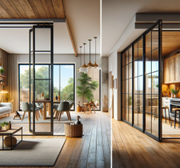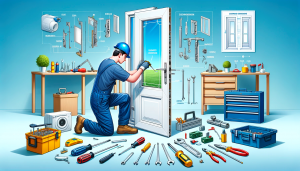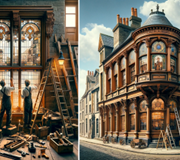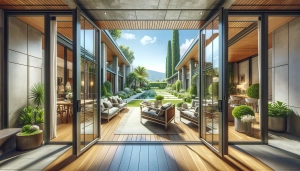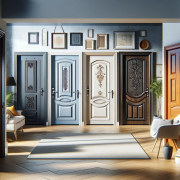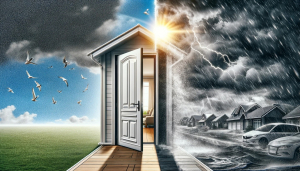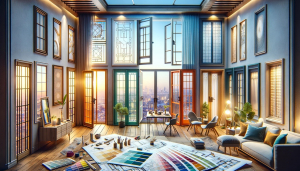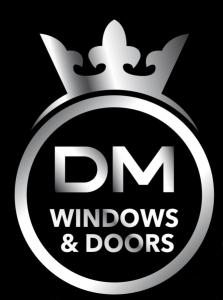Indoor Bi-Folding Options
Bi-folding doors are revolutionising the way we think about indoor spaces. No longer just a means to open or close an area, these innovative doors offer a blend of style, functionality, and space efficiency that is becoming increasingly popular in modern interior design.

Design and Aesthetic Appeal
The Art of Material Selection
At the heart of any bi-folding door’s aesthetic appeal is the material used. Glass, with its sleek, contemporary feel, invites natural light while creating a sense of openness. Wood, on the other hand, offers warmth and a classic touch, making it ideal for traditional or rustic interiors. Aluminium and UPVC provide durable, low-maintenance options, each bringing a unique style to the table.
Enhancing Interior Beauty
The design of bi-folding doors isn’t just about the materials; it’s how they transform a space. They create fluidity between rooms, enhance natural light, and offer versatility in design that traditional doors simply can’t match. Whether it’s a glass-panelled door that offers a view of the adjacent room or a wooden door that adds a cosy, private feel, these doors have the power to redefine an area’s aesthetics.
The Harmony of Function and Form
Bi-folding doors represent the marriage of beauty and practicality. Their sleek folding mechanism is a marvel of modern design, allowing for smooth operation without sacrificing visual appeal. This seamless integration of function and form makes them a preferred choice for those looking to add both efficiency and elegance to their indoor spaces.
Space Efficiency and Practicality
Maximising Limited Spaces
In urban homes where space is at a premium, bi-folding doors are a game-changer. They require far less space than traditional swing doors, making them ideal for small apartments or compact rooms. By folding neatly to one side, they allow for maximum utilisation of available space, whether it’s in a tiny kitchen, a small office, or a cosy living room.
Flexible Room Configurations
One of the greatest advantages of bi-folding doors is their ability to effortlessly transform a living space. They can open up two small rooms into one large area, perfect for gatherings or special occasions, and just as easily divide a large room into more intimate, private spaces. This flexibility is invaluable in modern living environments, where adaptability and versatility are key.
Practicality Meets elegance.
Beyond their space-saving benefits, bi-folding doors offer an elegance that enhances the practical aspects of any room. They provide easy access between indoor areas while maintaining an air of sophistication and modernity. Whether it’s creating an open-plan feel or offering a quick way to change the layout of a room, these doors combine practicality with an effortless elegance that enriches any interior setting.
Installation and Technical Aspects of Indoor Bi-Folding Doors
Technical Precision and Expertise Required
When it comes to installing indoor bi-folding doors, precision and expertise are key. The process involves several technical aspects that ensure the smooth operation and longevity of the doors.
The Installation Process
Installing bi-folding doors is a task that requires attention to detail. It typically involves setting up a track system on which the doors will glide. Ensuring that the tracks are perfectly aligned is crucial for the smooth operation of the doors. Additionally, the installation process also includes securing the door frames and ensuring that the folding mechanism aligns correctly.
Technical Considerations
There are several technical considerations to take into account when installing bi-folding doors. This includes the choice of the track system—top-hung or bottom-rolling—each with its own advantages and suitability depending on the door’s weight and structure. The alignment of the doors is also critical to prevent jamming or uneven wear.
Safety Features and Durability
Modern bi-folding doors come equipped with a range of safety features, such as finger-safe gaskets to prevent trapping injuries, which are especially important in homes with children. The durability of bi-folding doors is also a significant consideration, with many models designed to withstand heavy use and offer long-lasting performance.
Customisation and Personalisation Options
The Customisation Appeal of Indoor Bi-Folding Doors
One of the most appealing aspects of indoor bi-folding doors is the vast array of customisation options available, allowing homeowners to tailor them to their specific aesthetic and practical needs.
Variety in Finishes and Colours
Bi-folding doors come in a range of finishes and colours, enabling them to fit seamlessly into any interior design scheme. From natural wood finishes that offer a classic look to bold and contemporary colour options, there’s a style to suit every preference.
Hardware Customisation
The hardware of bi-folding doors—handles, hinges, and locks—can also be customised. This not only allows homeowners to choose a design that complements their doors but also provides an opportunity to enhance security features, such as multi-point locking systems.
Trends and Future Developments in Bi-Folding Doors
Bi-folding doors are continually evolving, with new trends and developments emerging in response to changing homeowner preferences and technological advancements.
Current Design Trends
Current trends in bi-folding doors lean towards minimalist and sleek designs, with slim frames and large glass panels that maximise natural light and views. The integration of smart home technology is also becoming increasingly popular, allowing for automated operation and enhanced security features.
Innovations on the Horizon
The future of bi-folding doors looks promising, with potential innovations in materials and technology. Advances in thermal efficiency, sound insulation, and even self-cleaning glass are on the horizon, aiming to enhance the functionality and appeal of bi-folding doors.
Shaping Future Homes
As preferences shift towards more open, flexible living spaces, bi-folding doors are set to play a key role in the design of future homes. Their ability to seamlessly blend indoor and outdoor spaces, coupled with their aesthetic appeal and practical benefits, ensures their continuing popularity and evolution.
In conclusion, indoor bi-folding doors represent a blend of modern practicality and aesthetic appeal, offering a transformative solution for contemporary living spaces. From their efficient space-saving design to the vast array of customisation options, these doors not only enhance the look and feel of a home but also provide functional benefits. With ongoing advancements in technology and design, bi-folding doors continue to evolve, promising to remain a popular and versatile choice for homeowners looking to create flexible, open, and inviting environments in their homes.

